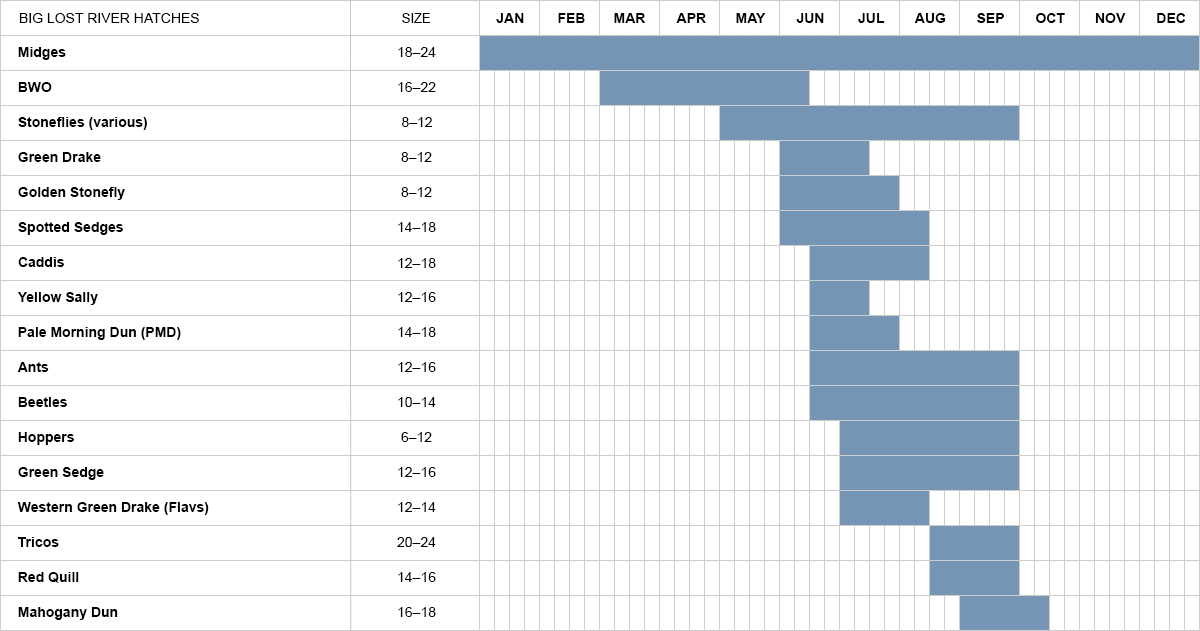Big Lost River is divided into two sections, the upper section (North Fork) which starts just northwest of Arco, Idaho and ends in MacKay Reservoir; and the lower section (East Fork) tailwater emitting from Mackay Reservoir. Both sections hold abundant populations of rainbow and cutthrout trout, and support a variety of seasonal fly hatches.

Fly fishing hatches and techniques vary depending on the section of the river you’re fishing and season. Large flies are the norm and nymphing is the most productive fly fishing technique. The are excellent midge, PMD, trico, BWO (baetis), and stonefly hatches throughout the year and matching the hatch is the best strategy. The following fly hatch chart lists the major fly hatches occurring on Big Lost River.
| Fly Hatch | Size | Date |
|---|---|---|
| Midges | 20 - 24 | Jan 1 - Dec 31 |
| BWO (Baetis) | 16 - 22 | Mar 15 - June 30; Sep1 - Oct 31 |
| Stoneflies (all species) | 6 -14 | May 1 - July 31 |
| PMD | 16 -18 | May 1 - Sep 30 |
| Caddis | 12 - 18 | May 1 - Oct 31 |
| Yellow Sally | 14 - 16 | May 15 - June 15 |
| Salmonfly | 4 - 6 | June 1 - July 15 |
| Golden Stonefly | 6 - 8 | June 15 - July 31 |
| Trico | 20 - 24 | July 1 - Sep 30 |
| Hoppers | 4 - 10 | July 1 - Oct 15 |
| Terrestrials | 6 - 14 | July 1 - Oct 31 |
Spring Hatches
Spring ushers in a plethora of aquatic insect life on the Big Lost River including a variety of midge, stonefly, and caddis hatches. Little Yellow Stoneflies, PMDs, and caddis show up in May. Stoneflies hatch through the end of the summer, PMDs are on the scene until autumn, and caddis hatches remain consistent through the end of October.
Baestis and midge hatches continue off and on throughout the spring into summer. A variety of sedges, including Short-horned and Green Sedges, may hatch in May and remain through June.
Summer Hatches
Summer is characterized by consistent mayfly hatches and the introduction of Salmonflies and Golden Stoneflies. Yellow Sally stoneflies continue to hatch through late June. Salmonfly nymphs emerge in early June and by the middle of the month are moving to the banks. Golden Stonefly hatches follow on the coat tails Salmonfly hatch and are usually over by end of July.
During the summer, the majority of mayfly hatches will be Pale Morning Duns (PMDs). Depending on the year, and stretch of river, PMDs appear in May and remain through the end of summer or early fall—but are most prolific June through August.
Fall Hatches
BMO hatches reappear in late August early September and can last through early October.
Terrestrials (ants, beetles, and grasshoppers) enter the scene mid/late June and are an important part of a trout’s diet through end of September. Fishing the vast stretches of tall grass along the banks using terrestrial patterns during July and August will produce some trophy catches.
Winter Hatches
During the winter months hatches consist primarily of Blue Winged Olives (BWO). BWOs are most prolific from September through November and again in early spring from March running into June. You’ll find spordic midge hatches throughout the year and midge imitation always your best bet.
Matching the Hatch and Fly Selection
Nymphing, dry flies, and streamers are all productive techniques. Fishing heavy streamers is one of the more effective ways to hook some lunker rainbows. Little Yellow, Salmonfly and Golden stonefly nymph imitation are hihgly recommended. BWO, PMD and midge nymph and dry fly patterns are must haves.



